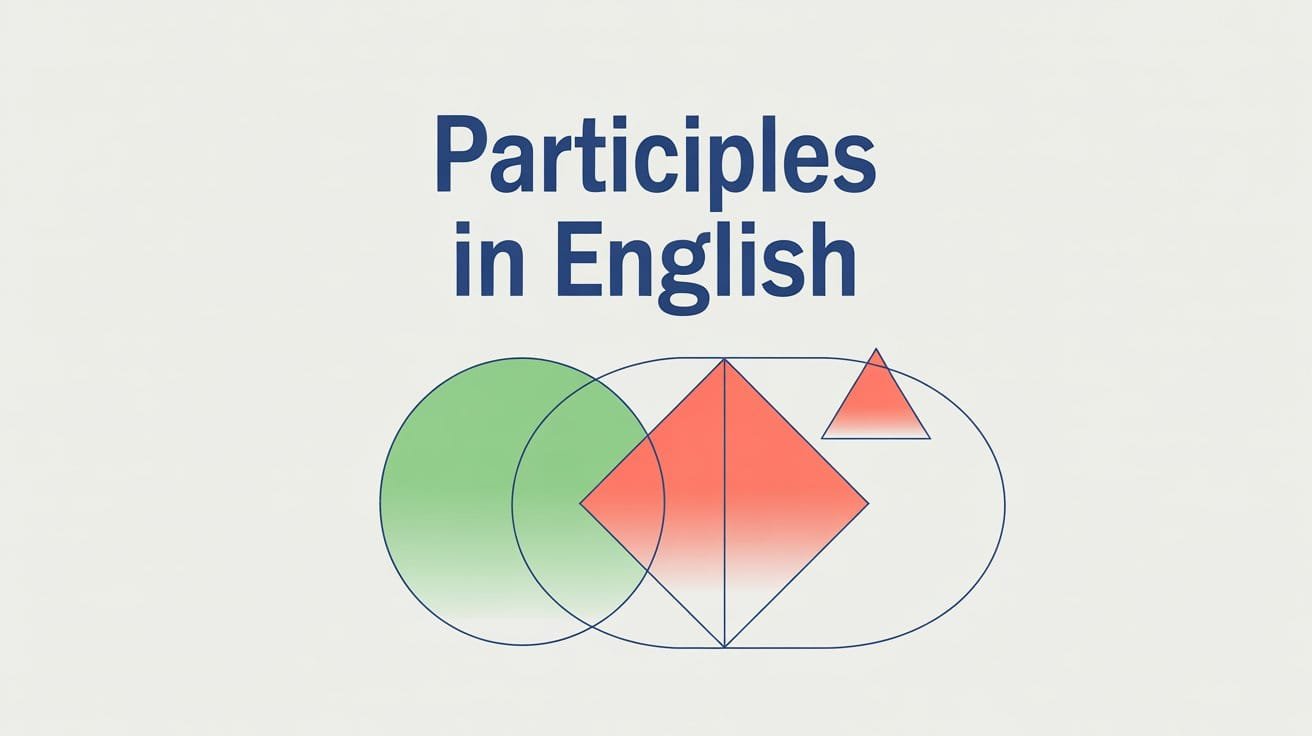Participles are verb forms that often act like adjectives or help build verb phrases in English. They belong to a group of forms known as verbals, words derived from verbs that don’t function as main verbs in a sentence. Even though participles come from verbs, they don’t always show action. Instead, they describe things or indicate time and voice in combination with auxiliary verbs.
For example, in “The smiling child waved back,” the word smiling is a participle describing the child—it’s not the main verb of the sentence. Understanding how participles work can help you write more clearly, avoid common mistakes, and add variety to your sentence structure.
Types of Participles in English
In English grammar, there are three main types of participles—present participles, past participles, and perfect participles. Each is formed differently and plays a distinct role in sentences.
Present Participles
A present participle ends in -ing and can function as part of a verb phrase or as an adjective.
- As part of a verb phrase:
They are watching a movie.
(are watching = present continuous tense) - As an adjective:
The boiling water spilled over.
(boiling describes the water)
Present participles are also used to form continuous (progressive) tenses in English.
Past Participles
A past participle usually ends in -ed (for regular verbs), but irregular verbs may have unique forms. It’s used in perfect tenses, passive voice constructions, and as an adjective.
- With perfect tenses:
She has finished the assignment.
(has finished = present perfect) - In passive voice:
The cake was baked by Leo.
(was baked = passive construction) - As an adjective:
The broken vase lay on the floor.
(broken describes the vase)
Perfect Participles
A perfect participle combines “having” + past participle. It’s often used to express a completed action before another.
Example: Having studied all night, Maya felt confident about the exam.
(The studying happened before she felt confident)
How Participles Work in Sentences
Participles are versatile. They can function as:
- Part of a verb phrase
- Adjectives
- Introductory phrases
- Reduced relative clauses
As Part of a Verb Phrase
Participles help form continuous and perfect tenses, as well as the passive voice.
- She was singing at the event. (Present participle in past continuous tense)
- We have seen that movie. (Past participle in present perfect)
- The documents were signed by the manager. (Past participle in passive voice)
As Adjectives
Participles describe nouns like regular adjectives but often convey action or state.
- The excited crowd cheered loudly.
- A glowing review boosted the book’s sales.
- He fixed the damaged door.
As Introductory or Modifying Phrases
A participial phrase can introduce a sentence or follow a noun, adding detail.
- Smiling confidently, she stepped onto the stage.
- Built in the 1800s, the house still stood strong.
These phrases should be placed close to the noun they describe to avoid dangling modifiers.
As Reduced Relative Clauses
Participles can replace relative clauses to make writing more concise.
- The man wearing a blue coat is my uncle.
(= The man who is wearing a blue coat…) - Books written by her are always interesting.
(= Books that are written by her…)
Common Errors with Participles (and How to Fix Them)
Dangling Participles
A dangling participle occurs when the participial phrase doesn’t clearly refer to the noun it’s supposed to modify.
❌ Running through the forest, the rain soaked my clothes.
(This makes it sound like the rain was running.)
✅ Running through the forest, I got soaked by the rain.
Tip: Make sure the subject that follows the participial phrase is the one performing the action in the phrase.
Misplaced Modifiers
Participial phrases placed too far from the noun they modify can confuse the reader.
❌ The boy gave the dog a treat wearing a red jacket.
(Who’s wearing the red jacket—the boy or the dog?)
✅ Wearing a red jacket, the boy gave the dog a treat.
Tip: Place the participial phrase directly before or after the noun it describes.
Overuse of Present Participles
Using too many -ing forms in a sentence can make writing feel repetitive or awkward.
❌ Walking to the store, checking her phone, sipping coffee, she almost tripped.
✅ As she walked to the store, she checked her phone and sipped her coffee.
Tip: Vary sentence structure to improve flow and clarity.
When to Use a Participle vs. a Full Clause
Choosing between a participle and a full clause depends on clarity, formality, and sentence structure. Both serve the purpose of adding detail, but they do it differently.
Use a Participle When
- You want a concise way to describe an action happening at the same time as the main verb.
- Holding her umbrella tightly, Mia crossed the street.
(Concise and clear. The participial phrase gives extra info about Mia.)
- Holding her umbrella tightly, Mia crossed the street.
- The subject of the participle and the main clause is the same.
- Typing quickly, James finished the report on time.
- You’re writing in a more descriptive or narrative style.
- Barking loudly, the dog chased the bicycle.
Caution: Only use a participle when there’s no confusion about the subject.
Use a Full Clause When
- The subject of the descriptive action is different from the subject of the main clause.
- While the children played outside, the parents prepared dinner.
- You need more precision or are writing formally.
- Because she was tired, Lily went to bed early.
- The participle would make the sentence ambiguous or awkward.
- ❌ Swimming in the pool, the thunder startled him.
✅ While he was swimming in the pool, thunder startled him.
- ❌ Swimming in the pool, the thunder startled him.
Tip: If clarity is ever in doubt, go with a full clause.
FAQs About Participles in English
What is the difference between a participle and a gerund?
A participle acts like an adjective, describing a noun (e.g., the smiling child). A gerund functions as a noun (e.g., Swimming is my favorite activity).
Can a participle come after the noun?
Yes, especially in reduced relative clauses. Example: The book written by Sarah is a bestseller.
Are participles always -ing or -ed forms?
Mostly, yes. Present participles end in -ing (laughing, running), and past participles often end in -ed (baked, painted), though irregular verbs may have different forms (written, gone).
What’s a dangling participle?
A dangling participle is when the participial phrase doesn’t match the subject, leading to confusion.
❌ Walking down the street, the flowers caught my eye.
(This makes it seem like the flowers were walking.)
✅ Walking down the street, I noticed the flowers.
Can participles appear in passive voice?
Yes, past participles are used in passive constructions. Example: The cake was baked by Maria.



